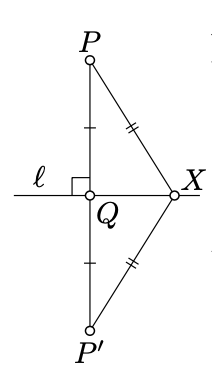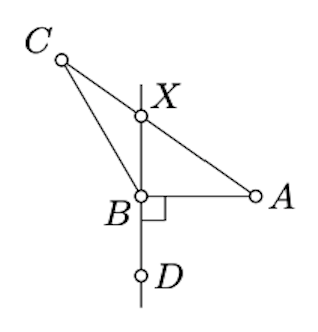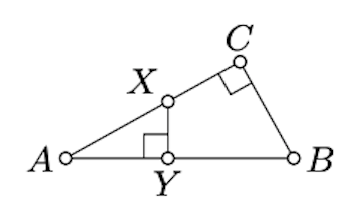5.5: Perpendicular is shortest
( \newcommand{\kernel}{\mathrm{null}\,}\)
Assume Q is the foot point of P on the line ℓ. Then the inequality
PX>PQ
holds for any point X on ℓ distinct from Q.
If P,Q, and ℓ are as above, then PQ is called the distance from P to ℓ.
- Proof
-
If P∈ℓ, then the result follows since PQ=0. Further we assume that P∉ℓ.

Let P′ be the reflection of P across the line ℓ. Note that Q is the midpoint of [PP′] and ℓ is the perpendicular bisector of [PP′]. Therefore
PX=P′X and PQ=P′Q=12⋅PP′
Note that ℓ meets [PP′] only at the point Q. Therefore, X∉[PP′]; by triangle inequality and Corollary 4.4.1,
PX+P′X>PP′
and hence the result: PX>PQ.
Assume ∠ABC is right or obtuse. Show that
AC>AB.
- Hint
-

If ∠ABC is right, the statement follows from Lemma 5.5.1. Therefore, we can assume that ∠ABC is obtuse.
Draw a line (BD) perpendicular to (BA). Since ∠ABC is obtuse, the angles DBA and DBC have opposite signs.
By Corollary 3.4.1, A and C lies on opposite sides of (BD). In particular, [AC] intersects (BD) at a point; denote it by X.
Note that AX<AC and by Lemma 5.5.1, AB≤AX.
Suppose that △ABC has right angle at C. Show that for any X∈[AC] the distance from X to (AB) is smaller than AB.
- Hint
-

Let Y be the foot point of X on (AB). Apply Lemma 5.5.1 to show that XY<AX≤AC<AB.


